kobe beef au poivre
- FH

- May 10, 2022
- 3 min read
my version -- fusion of Japanese/French techniques; served with char grilled eggplant, bok choy, cherry tomatoes; mash potatoes; and mango green salad with carrot dressing...

"When consumers hear the term Kobe, the first thought that comes to mind is typically not a city in Japan, but rather a juicy steak right off the grill. Kobe beef is globally renowned for its rich flavor, juiciness, and tenderness or high marbling content. Kobe beef is cuts of beef from the Tajima strain of Wagyu cattle (which mean Japanese cattle), raised in Kobe, Japan. But did you know you can find Kobe-style beef produced right here in the United States?Since 1994, U.S. producers have worked to offer American Kobe-style beef that features the same characteristics, marbling and flavor that defines Japan’s Kobe beef by bringing herds of Kryoshi and Akaushi breeds of Wagyu cattle to the United States. The same closed herd and multi-trait selection process used for Kobe beef was adopted and is now used by various U.S. trade associations (American Akaushi Association, the American Wagyu Association, and the Texas Wagyu Association) that promote and uphold the industry standards. Highly prized for their rich flavor, these cattle produce what some would argue is among the finest beef in the world. -- USDA
>> see my tuna au poivre here.
my beef tenderloin with peppercorn cream sauce (steak au poivre)
this version -- seared and roasted with garlic and thyme; sauce cooked with cream, french brandy; served with roasted potatoes and sautéed mushrooms...
“Steak a la Diane,”named after the Roman goddess of the hunt. The renowned Auguste Escoffier gave us a recipe for pepper sauce intended for venison in Le Guide Culinaire, published in 1903. French chefs simplified the dish after the turn of the century, calling it "steak au poivre” for the first time. Venison steak was replaced with crushed peppercorn-encrusted beef, which was pan seared and served with a brandy, butter, and (sometimes) cream-based sauce. The dish was often cooked table-side because when the brandy was added to the hot pan it resulted in an impressive tower of vaporized alcohol flames.
In the 1960s, American home cooks were introduced to the cuisine of France by Julia Child. Child’s longtime friend Jacques Pépin remembered her in the New York Times as “… almost a foot taller than I and her voice was unforgettable — shrill and warm at the same time.” -- Four Pounds Flour
"The loin is the muscle that does the least amount of work thus the tenderloin provides the most tender cut of meat for roasts and steaks. Filet mignon is part of a beef tenderloin, but a beef tenderloin is not a filet mignon. Instead, it houses the filet mignon, which comes from the end portion of the tenderloin. The rest of the tenderloin can create other steak cuts or a delicious tenderloin roast to feed the family." -- Food Network
"Traditional French chateaubriand is served with a red wine sauce, but the sauce for this beef tenderloin recipe is a recreation of a creamy green peppercorn sauce. After removing the meat, use the same skillet to saute shallots until soft over medium-high heat while the tenderloin rests." -- Michelle
"Chateaubriand is a dish that traditionally consists of a large center cut fillet of tenderloin grilled between two lesser pieces of meat that are discarded after cooking." -- Wikipedia





























Comments